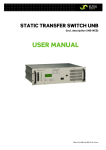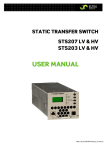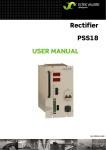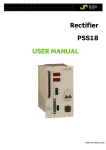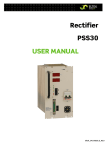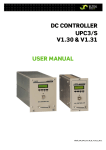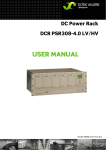Download Eltek Valere UNV-F 2.5 User manual
Transcript
STATIC TRANSFER SWITCH UNB USER MANUAL UM_UNB_E_R04 Static Transfer Switch UNB User Manual Page 2 (28) Notes on this manual ATTENTION! Read this manual very carefully before installing and commissioning the specified module. This manual is a part of the delivered module. Familiarity with the contents of this manual is required for installing and operating the specified module. The rules for prevention of accidents for the specific country and the general safety rules in accordance with IEC 364 must be observed. The function description in this manual corresponds to the date of publishing. Technical changes and changes in form and content can be made at any time by the manufacturer without notice. There are no obligations to update the manual continually. The module is manufactured in accordance with applicable DIN and VDE standards such as VDE 0106 (part 100) and VDE 0100 (part 410). The CE marking on the module confirms compliance with EU standards 2006-95-EG (low voltage) and 2004-108-EG (electromagnetic compatibility) if the installation and operation instructions are followed. Supplier: FAX Email Internet ELTEK VALERE DEUTSCHLAND GmbH GB Industrial Schillerstraße 16 D-32052 Herford + 49 (0) 5221 1708-210 + 49 (0) 5221 1708-222 [email protected] http://www.eltekvalere.com Changes and errors excepted. 2009. ELTEK VALERE DEUTSCHLAND GmbH. All rights reserved. ELTEK VALERE DEUTSCHLAND ©2009 UM_UNB_E_R04 Static Transfer Switch UNB User Manual Page 3 (28) Current revision status of this user manual Revision: 04 Date: 2010-05-14 Revision Description of change Writer Date 01 First edition RTH 2007-04-26 02 Layout change, minor text modifications, UNB30.0 inserted. RTH 2008-01-14 03 Minor text modifications, “Remote switch ON” added. RTH 2008-06-05 04 Minor text modifications at section 2.2 "Operating modes". RTH 2010-05-14 ELTEK VALERE DEUTSCHLAND ©2009 UM_UNB_E_R04 Static Transfer Switch UNB User Manual Page 4 (28) Table of Contents 1A. SAFETY INSTRUCTIONS..............................................................................................................................................5 1B. ELECTRIC WASTE DISPOSAL ......................................................................................................................................5 2. GENERAL INFORMATION................................................................................................................................................6 2.1 Example of use .........................................................................................................................................................6 2.2 Operating modes......................................................................................................................................................7 2.2.1 "Inverter priority" (default setting) ....................................................................................................................................7 2.2.2 "Mains priority" .......................................................................................................................................................................7 3. TYPE LIST AND MAIN DATA..........................................................................................................................................8 3.1 Optional equipment for UNB assembly: .............................................................................................................9 3.2 Front View and Operating Elements ...................................................................................................................9 3.2.1 Front view UNB5.0/12.5kVA...............................................................................................................................................9 3.2.2 Front view UNB23.0/30.0/40.0kVA............................................................................................................................... 10 3.3 Electrical Connectors........................................................................................................................................... 11 3.3.1 Input terminals .................................................................................................................................................................... 11 3.3.2 Output terminals................................................................................................................................................................. 11 3.3.3 Connectors UNB 5.0 and UNB 12.5kVA ........................................................................................................................ 12 3.3.4 Connectors UNB 23.0kVA ................................................................................................................................................ 13 3.3.5 Connectors UNB 30.0kVA & UNB 40.0kVA................................................................................................................... 14 3.3.6 Pinning of the CAN bus connectors ............................................................................................................................... 15 3.3.7 Connector (Sub-Min-D, 9-pole)......................................................................................................................................... 15 3.5 Cooling/Air flow direction ................................................................................................................................... 16 3.6 CAN-Bus Communication Interface .................................................................................................................. 17 4. HANDLING...................................................................................................................................................................... 18 4.1 Storage .................................................................................................................................................................... 18 4.2 Commissioning....................................................................................................................................................... 18 4.3 Operation................................................................................................................................................................. 18 4.3.1 LED indication ...................................................................................................................................................................... 18 4.3.2 Adjustment keys................................................................................................................................................................. 19 4.3.3 LCD panel / Indication of measuring values & alarm messages ............................................................................. 20 4.4 Parameter adjustments ...................................................................................................................................... 21 4.4.1 Table “Adjustable Parameters” (customer menu) ...................................................................................................... 21 4.4.2 Diagram “Customer menu” ............................................................................................................................................... 22 5. MAINTENANCE ............................................................................................................................................................. 24 6. TROUBLE SHOOTING ................................................................................................................................................... 24 7. TECHNICAL SPECIFICATIONS..................................................................................................................................... 25 7.1 Dimensional Drawings UNB5.0/12.5 kVA: ...................................................................................................... 27 7.2 Dimensional Drawings UNB23.0kVA, UNB30.0kVA & 40.0 kVA: ............................................................... 27 7.3 Photo UNB5.0/12.5kVA ...................................................................................................................................... 28 7.4 Photo UNB23.0/30.0/40.0kVA ......................................................................................................................... 28 ELTEK VALERE DEUTSCHLAND ©2009 UM_UNB_E_R04 Static Transfer Switch UNB User Manual Page 5 (28) 1A. Safety Instructions Warning! Because several components of operating electrical modules are charged by dangerous voltage, the improper handling of electrical modules may be the cause of accidents involving electrocution, injury, or material damages. Operation and maintenance of electrical modules must be performed by qualified skilled personnel such as electricians in accordance with EN 50110-1 or IEC 60950. Install the module only in areas with limited access to unskilled personnel. Before starting work, the electrical module must be disconnected from mains. Make sure that the module is earthed. Do not touch connector pins as they can be charged with dangerous voltage up to 30 seconds after disconnection. Only spare parts approved by the manufacturer must be used. 1B. Electric Waste Disposal Separate collection is the precondition to ensure specific treatment and recycling of waste electrical and electronic equipment and is necessary to achieve the chosen level of protection of human health and the environment. In the case of waste disposal of your discarded equipment we recommend to contact a waste management company. ELTEK VALERE DEUTSCHLAND ©2009 UM_UNB_E_R04 Static Transfer Switch UNB User Manual Page 6 (28) 2. General Information An electronic transfer switch is to be used if critical consumer loads have to be switched over nearly interruption free between two AC sources (usually inverters and substitute-mains) with a reaction time which is not able to be reached with a manual (mechanical) bypass switch. The electronic transfer switch guarantees the synchronization of frequency and phase of the inverter with mains and a switch over from the disturbed source to the alternative source within 0.5 to 4.0ms depending on the adjusted sensitivity (factory setting, only adjustable by skilled service personnel). Switching over again takes place interruption free at the zero point of the voltage. In case of synchronization error between mains and inverters switching over takes place with a delay time of maximum 12ms. Static transfer switches of series UNB are available for delivery with power rating of 5.0KVA to 40.0KVA and are to be used for the operation with inverters of series UNV and PWS. Typical applications are the use in UPS systems designed with input side rectifiers, battery circuit and output side inverters. The UNB is a 19’’-compatible rack according to DIN41494 with rear side connectors. The CAN bus connectors as well as any operating elements and indicators are user-friendly integrated in the front plate of the unit. 2.1 Example of use Static transfer switch UNB connected between inverter output side and mains 230VAC: ELTEK VALERE DEUTSCHLAND ©2009 UM_UNB_E_R04 Static Transfer Switch UNB User Manual Page 7 (28) 2.2 Operating modes The static transfer switch UNB is designed for the operating modes “inverter priority” and “mains priority” alternatively. Source 1 is defined as priority source, source 2 is defined as substitute source. Source 1 feeds the load as long as source 1 works faultlessly. 2.2.1 "Inverter priority" (default setting) REMARK: The unit's default setting is "Inverter priority". In this case the inverters are source 1, mains is source 2. The UNB switches to source 2 if source 1 fails or is overloaded (i.e. distortions by short circuit behaviour or overload). REMARK: The priority source is programmable using service menu 2. 2.2.2 "Mains priority" At operating mode “mains priority” AC mains works as source 1 and the inverter(s) as source 2. ELTEK VALERE DEUTSCHLAND ©2009 UM_UNB_E_R04 Static Transfer Switch UNB User Manual Page 8 (28) 3. Type List and Main Data Type Designation Material Code Battery Voltage (VDC) UNB5.0-24 600-050-411.00 24 Rated Output Power (kVA @ 230VAC) 5.0 UNB5.0-48 600-050-511.00 48 5.0 UNB5.0-60 600-050-611.00 60 5.0 UNB5.0-110 600-050-711.00 108 5.0 UNB5.0-220 600-050-811.00 216 5.0 UNB12.5-24 600-125-411.00 24 12.5 UNB12.5-48 600-125-511.00 48 12.5 UNB12.5-60 600-125-611.00 60 12.5 UNB12.5-110 600-125-711.00 108 12.5 UNB12.5-220 600-125-811.00 216 12.5 UNB23.0-24 600-230-411.00 24 23.0 UNB23.0-48 600-230-511.00 48 23.0 UNB23.0-60 600-230-611.00 60 23.0 UNB23.0-110 600-230-711.00 108 23.0 UNB23.0-220 600-230-811.00 216 23.0 UNB30.0-24 600-300-411.00 24 30.0 UNB30.0-48 600-300-511.00 48 30.0 UNB30.0-60 600-300-611.00 60 30.0 UNB30.0-110 600-300-711.00 108 30.0 UNB30.0-220 600-300-811.00 216 30.0 UNB40.0-24 600-400-411.00 24 40.0 UNB40.0-48 600-400-511.00 48 40.0 UNB40.0-60 600-400-611.00 60 40.0 UNB40.0-110 600-400-711.00 108 40.0 UNB40.0-220 600-400-811.00 216 40.0 See section 7) for detailed technical data. ELTEK VALERE DEUTSCHLAND ©2009 UM_UNB_E_R04 Static Transfer Switch UNB User Manual Page 9 (28) 3.1 Optional equipment for UNB assembly: Article Article code Suitable for: Mounting-kit 880-MEC-MKT.01 UNB5.0 & UNB12.5 type series Mounting-kit 880-MEC-MKT.03 UNB23.0, UNB30.0 & UNB40.0 type series 3.2 Front View and Operating Elements 3.2.1 Front view UNB5.0/12.5kVA CAN Connectors Digital Display Sub-Min-D (not used) LED Indications Adjustment Keys ELTEK VALERE DEUTSCHLAND ©2009 UM_UNB_E_R04 Static Transfer Switch UNB User Manual Page 10 (28) 3.2.2 Front view UNB23.0/30.0/40.0kVA Sub-Min-D (not used) Digital Display CAN Connectors LED Indications Adjustment Keys All operating elements and indicators are located at the front of the modules: 4 adjustment keys: (up), (down), “ESC”, “ENTER”. 7 LED indications: “STANDBY”, “SOURCE 1”, “SOURCE 2”, “SYNCHR.”, “LOAD ON INVERTER”, “LOAD ON MAINS”, “ALARM”. Digital display For detailed information concerning operating elements, LED indicators, digital display and connectors please see the following chapters. ELTEK VALERE DEUTSCHLAND ©2009 UM_UNB_E_R04 Static Transfer Switch UNB User Manual Page 11 (28) 3.3 Electrical Connectors 3.3.1 Input terminals The UNB is equipped with two AC inputs, one for the inverter and the other for the substitute-mains. Both sources must have the same frequency and the same nominal voltage level. Because there are no protection fuses integrated in the unit, both sources must be protected externally. If several inverters are connected in parallel, the parallel connection of the inverter outputs has to be arranged externally. REMARK: If inverters of series PWS are connected in parallel, a symmetry-choke per inverter additionally is to be installed into the L-phase. The AC input connectors are located on the rear side of the unit. Because of the limited load capacity of the connector pins the UNB with an output power of 23.0kVA is equipped with two connectors, the 30.0 & 40.0kVA unit with three connectors with several contact pins connected in parallel accordingly. In that case the contact pins require an identical cable diameter and length. This applies also to the AC output connection terminal which is described in the following. Additional the UNB is equipped with a DC input for the connection with the battery of the system. The internal electronic circuit of the UNB is supplied by mains and additionally by the battery (redundancy). The voltage level of the battery is monitored by the UNB; the result is used for switching off the inverters in case of over/under voltage. The UNB measures and monitors the voltage level of both input sources (real effective values) and additional the frequencies. The thresholds of those measuring values are programmable (factory setting, only practicable by skilled service personnel). 3.3.2 Output terminals The unit is equipped with a plug-in AC output connection terminal. In case of short circuit, the short circuit power is transferred to the UNB input, which causes the fuse of source 1 or 2 to blow. The UNB may be overloaded only for short-time (see technical data). In particular this is to be observed for the correct dimensioning of the pre-fuse. The pre-fuse must be dimensioned according to the nominal output power of the UNB. If the pre-fuse is overdimensioned, the resultant delayed fuse tripping may destroy the internal thyristors of the UNB. The operation of the UNB in combination with inverters of series UNV: The UNB measures and monitors the current of the consumer load. In order to avoid a permanent overload of the inverters the UNB verifies the availability of the connected inverters and anew calculates the allowed total current of the consumer load. If one of the inverters in parallel operation fails, the overload threshold value automatically is reduced. ELTEK VALERE DEUTSCHLAND ©2009 UM_UNB_E_R04 Static Transfer Switch UNB User Manual Page 12 (28) 3.3.3 Connectors UNB 5.0 and UNB 12.5kVA 1 3 X1 2 4 View from the rear: UNB 5.0/12.5kVA 9 5 10 6 11 7 12 8 Connector X1 (HAN-K4/8, socket outlet) Pins (X1) 1 2 3 4 5 6 7 8 9 10 11 12 Function Source 1 (inverter)/Phase L1 Source 2 (substitute mains)/Phase L1 Source 1 & 2/ neutral UNB Output/Phase L1 DC-supply / L+ (24 / 48 / 108 / 216V DC) DC-supply / L- (24 / 48 / 108 / 216V DC) Synchronization / SYNC-SIG Synchronization / SYNC-STAT Remote switch ON (+24V) Indication relay general fault / NO Indication relay general fault / COM* Synchronization / SYNC-GND *Function logic: OK = COM and NO closed (Is equal to the programming “not inverted”) REMARK: If the UNB works in combination with a single inverter or inverters in parallel operation it is necessary to connect through the synchronization bus (contacts SYNC-GND→ SYNC-GND, SYNC-SIG→ SYNC-SIG and SYNCSTAT→ SYNC-STAT) between the inverter(s) and the UNB. ELTEK VALERE DEUTSCHLAND ©2009 UM_UNB_E_R04 Static Transfer Switch UNB User Manual Page 13 (28) 3.3.4 Connectors UNB 23.0kVA 1 1 X2 3 3 2 X1 2 4 View from the rear: UNB 23.0kVA 4 9 5 9 5 10 6 10 6 11 7 11 7 12 8 12 8 Connector X1 Connector X2 (HAN-K4/8, socket outlet) Pins (X1) 1 2 3 4 5 6 7 8 9 10 11 12 Function Source 1 (inverter)/Phase L1 Source 2 (substitute mains)/Phase L1 Source 1 & 2/ neutral UNB Output/Phase L1 DC-supply / L+ (24 / 48 / 108 / 216V DC) DC-supply / L- (24 / 48 / 108 / 216V DC) Synchronization / SYNC-SIG Synchronization / SYNC-STAT Indication relay general fault / NC Indication relay general fault / NO Indication relay general fault / COM* Synchronization / SYNC-GND Pins (X2) 1 2 3 4 5 Function Source 1 (inverter)/Phase L1 Source 2 (substitute mains)/Phase L1 No connection UNB Output/Phase L1 No connection 6 7 8 9 10 11 12 No connection No connection No connection Remote switch ON (+24V) No connection No connection No connection *Function logic: fault = COM and NC closed OK = COM and NO closed (Is equal to the programming “not inverted”) REMARK: If the UNB works in combination with a single inverter or inverters in parallel operation it is necessary to connect through the synchronization bus (contacts SYNC-GND→ SYNC-GND, SYNC-SIG→ SYNC-SIG and SYNCSTAT→ SYNC-STAT) between the inverter(s) and the UNB. ELTEK VALERE DEUTSCHLAND ©2009 UM_UNB_E_R04 Static Transfer Switch UNB User Manual Page 14 (28) 3.3.5 Connectors UNB 30.0kVA & UNB 40.0kVA 1 1 3 3 3 2 View from the rear: UNB 30.0/40.0kVA 1 2 4 2 4 4 9 5 9 5 9 5 10 6 10 6 10 6 11 7 11 7 11 7 12 8 12 8 12 8 Connector X1 Connector X2 Connector X3 (HAN-K4/8, socket outlet) Pins (X1) 1 2 3 4 5 6 7 8 9 10 11 12 Function Source 1 (inverter) / Phase L1 Source 1 (inverter) / Phase L1 Source 1 (inverter) / Phase L1 No connection No connection Synchronization / SYNC-GND Synchronization / SYNC-SIG Synchronization / SYNC-STAT Remote switch ON (+24V) No connection No connection No connection Pins (X2) 1 2 3 4 5 6 7 8 9 10 11 12 Function Source 2 (substitute mains) / Phase L1 Source 2 (substitute mains) / Phase L1 Source 2 (substitute mains) / Phase L1 Source 1 & 2 / neutral DC-supply / L+ DC-supply / LNo connection No connection No connection Indication relay general fault / COM* Indication relay general fault / NO Indication relay general fault / NC *Function logic: fault = COM and NC closed OK = COM and NO closed (Is equal to the programming “not inverted”) REMARK: If the UNB works in combination with a single inverter or inverters in parallel operation it is necessary to connect through the synchronization bus (contacts SYNC-GND→ SYNC-GND, SYNC-SIG→ SYNC-SIG and SYNCSTAT→ SYNC-STAT) between the inverter(s) and the UNB. Pins (X3) 1 2 3 4 5 6 7 8 9 10 11 12 Function UNB Output/Phase L1 UNB Output/Phase L1 UNB Output/Phase L1 No connection No connection No connection No connection No connection No connection No connection No connection No connection ELTEK VALERE DEUTSCHLAND ©2009 UM_UNB_E_R04 Static Transfer Switch UNB User Manual Page 15 (28) 3.3.6 Pinning of the CAN bus connectors The UNB is equipped with 2 CAN connectors (CAN1 and CAN2) at the front of the unit. CA N 1 6 CAN bus connector (socket outlet RJ11, 6 pole) Pinning table: Pin Signals CAN1 Signals CAN2 Designation 1 CAN_V+ DC-Supply +8...15V 2 CAN_V+ DC-Supply +8...15V 3 CAN_H Signal (high) 4 CAN_L Signal (low) 5 CAN_V- DC-Supply Ground 6 CAN_V- DC-Supply Ground 3.3.7 Connector (Sub-Min-D, 9-pole) Additional a connector (Sub-Min-D, 9-pole) is located at the front of the UNB. REMARK: This connector is not used. ELTEK VALERE DEUTSCHLAND ©2009 UM_UNB_E_R04 Static Transfer Switch UNB User Manual Page 16 (28) 3.5 Cooling/Air flow direction The unit is cooled with an internal fan. The airflow is from the front to rear side. The fan is monitored and speed controlled by device temperature. For a sufficient airflow a minimum space (A) of 50 mm between the unit and the rear cabinet wall as well as an unobstructed influx of supply air from front side is necessary. ELTEK VALERE DEUTSCHLAND ©2009 UM_UNB_E_R04 Static Transfer Switch UNB User Manual Page 17 (28) 3.6 CAN-Bus Communication Interface The UNB is equipped with a serial data interface according to CAN (= Controller Area Network) -specification. Two CAN-Bus connectors are integrated in the front plate of the unit. The UNB communicates via CAN-Bus with the connected inverters and a possibly implemented supervision monitoring device (UPC3 or MU1000C). Following information is available via the CAN-Bus: Status information of the UNB Availability of the connected inverters Availability of the substitute mains Output current of the UNB Device temperature Battery-voltage at the UNB Frequency of source 1 and source 2 Input- and output values of the connected inverters as follows: o Input current o Input voltage o Output current o Output voltage o Output frequency o Device state (okay/not okay) (The values are measured at regular intervals via the CAN-Bus and can be called in the display). If the signal to one of the connected inverters is interrupted, the failure message “CAN failure” is indicated and the number of the particular inverter is shown. The numbering of the inverters automatically follows the CAN addresses in ascending order which have been adjusted at the inverters. The output voltage of the connected inverters is controlled by the UNB via CAN-Bus according to the adjusted value “mains voltage” in the service menu 1 (factory setting, only practicable by skilled service personnel). When the CAN-Bus connection is inactive for more than 5 seconds the inverters automatically switch back to the internally stored default values. The inverters are switched off by the UNB if Ubatt> Umax (default value= 2.5V x number of cells) or Ubatt< Umin (default value= 1.7V x number of cells) is detected by the UNB. ATTENTION: The internally stored value (output voltage of the inverter Uo) must be the same for all of the inverters which are connected in parallel and the same value must be adjusted at the UNB. Detailed information regarding the adjustment of “Uo” can be found in the user manuals of the particular inverters. The CAN bus is not relevant for the synchronization of the inverters. For safety reasons, the synchronization takes place via the hard-wired synchronization bus between inverters and UNB (please see section 3.3.3 ff “connectors”). ELTEK VALERE DEUTSCHLAND ©2009 UM_UNB_E_R04 Static Transfer Switch UNB User Manual Page 18 (28) 4. Handling 4.1 Storage The UNB must be stored in a dry, dust free environment with a storage temperature according to specified data (see section 7). 4.2 Commissioning Note: Before commissioning the module make sure that the voltage level of both input sources and the battery voltage correspond to the values according to the type plate of the UNB. To mount the inverter in a 19’’ compatible cabinet, a mounting-kit according to section 3.1 is necessary. After unpacking the unit put it upon the rails and slide in the unit carefully over the rails until the module connector gets in touch with the backplane connector. Increase the pressure until the unit fits in completely. Please avoid too much pressure. If the unit does not fit in please start again with the complete slide-in process. Mount the unit with 4 screws (M4x12). Caution: The unit is delivered without internal fuses. Therefore the unit has to be fused externally at the input source “mains” to protect the internal thyristors against damages in case of short circuit. The pre-fuse must be dimensioned according to the nominal output power of the UNB. In case of inverters in parallel operation, the output of each inverter has to be fused. 4.3 Operation The operation and adjustment respectively of the unit takes place with keys located at the front side of the unit. All main functional parameters and measuring values are displayed on the front side LCD panel (text indicator) as well as with LED indications. They are described in the following. 4.3.1 LED indication LED Indication Colour STANDBY green The UNB is switched on and operational SOURCE 1 green SOURCE 2 Operation mode Voltage and frequency of source 1 (priority source) are within allowable range Voltage and frequency of source 2 (substitute green source) are within allowable range SYNCHR. green Inverters are synchronised with mains by UNB LOAD ON INVERTER green Load fed by inverter LOAD ON MAINS green Load fed by mains ALARM red ELTEK VALERE DEUTSCHLAND ©2009 General Alarm (the assignment of the individual alarm messages is programmable) UM_UNB_E_R04 Static Transfer Switch UNB User Manual Page 19 (28) 4.3.2 Adjustment keys The adjustment takes place with the four front keys: Front keys Indication Function Up during menu item selection: change to previous item (parameter) during adjustment mode: increase value during menu item selection: change to next item (parameter) during adjustment mode: decrease value Escape leave the menu without changing Enter call menu leave menu with changing save parameter Down ELTEK VALERE DEUTSCHLAND ©2009 UM_UNB_E_R04 Static Transfer Switch UNB User Manual Page 20 (28) 4.3.3 LCD panel / Indication of measuring values & alarm messages In the initial state the display shows the measuring values of the input sources (AC output voltage of inverter, mains voltage, output current, date and time, additional frequencies of inverter and mains and battery voltage as well as the total DC-current). (The example above shows six registered inverters) Display [1] shows the initial state (basic display). The plain text of the basic display becomes visible after a successful start-up procedure. According to the diagram above you can select the displays [1], [2] and [3] by pushing the keys or : If no inverter is registered, display [3] is not available. If exactly one inverter is registered, display [3] is visible without inverter number. If more than one inverter is registered, it is possible to call the parameters (input current, output current and status) of all connected inverters in succession by pressing “ENTER”. The inverter number is shown in the first line of the display. The display will automatically revert to display [1] if no key is pressed for a period of more than 30 seconds. Display [4] “Alarm messages” indicates the current alarm status. It can be selected from display [1] or [2] by pressing “ESC”. With pressing the keys or you can leaf through the list of alarm messages if more than three entries are present there. The display “Alarm messages” can be quit by pressing “ESC” again. Basically (factory setting) all individual failures according to “list of the selectable individual collective failures“ (please see section 4.4.1) are switched “active” and therefore they are visible on the display in case of failure. The alarm messages which shall not be visible on the display in case of failure are to be switched “inactive” in the customer menu (please see the diagram “Customer menu”). ELTEK VALERE DEUTSCHLAND ©2009 UM_UNB_E_R04 Static Transfer Switch UNB User Manual Page 21 (28) 4.4 Parameter adjustments REMARK: The configuration of the system during commissioning takes place with the service menu 1 and 2 and the calibration menu. They are code protected to guard against illegal parameter changes. The special documents only are available for qualified and skilled service personnel. In the following the adjustable parameters in the customer menu (available for each customer) are described. 4.4.1 Table “Adjustable Parameters” (customer menu) In the customer menu the parameters can be adjusted according to the table: Menu item Functions Range Default value (factory setting) INV-count Key in the number of the connected inverters* 0- 15 0 Time/Date Adjustment of the real time clock Configuration CF Selection (switching active/inactive) of individual failures for the collective failure signalisation= General Alarm (LED and Relay) All individual failures** All active Delay LED CF LED time delay of the collective failure signal 1- 60 sec 30 Delay Relay CF Time delay of the collective failure relay 1- 60 sec 30 LCD-contrast Contrast adjustment of the display 0- 255 220 LCD backlight Background illumination On / off On Language Selection of the language English, German, Polish, Swedish, Italian English Softw. version? Shows the current firmware version Read only * If the UNB works together with inverters of type PWS, the INV-count must be set to “0” because the PWS is not equipped with a CAN interface. Otherwise, the failure message “Inverter fail.” would be generated. **List of the selectable individual collective failures (CF): o Source 1 fail. o Source 2 fail. o Synchr. Error o Inverter fail. o UNB overtemp. o UNB overload o INV overload o DC voltage low o DC voltage high o Ubatt< warning o Ubatt> warning ELTEK VALERE DEUTSCHLAND ©2009 UM_UNB_E_R04 Static Transfer Switch UNB User Manual Page 22 (28) 4.4.2 Diagram “Customer menu” The customer menu can be entered from the basic display by pressing ENTER for around 3 seconds and then press ENTER again. A list of all selectable individual collective failures (CF) is shown on the previous page. ELTEK VALERE DEUTSCHLAND ©2009 UM_UNB_E_R04 Static Transfer Switch UNB User Manual Page 23 (28) The final display provides information about the currently used firmware version. ELTEK VALERE DEUTSCHLAND ©2009 UM_UNB_E_R04 Static Transfer Switch UNB User Manual Page 24 (28) 5. Maintenance In general, the static transfer switch UNB is maintenance-free. A yearly inspection with following checks is simply recommended: Correct fan operation Mechanical inspection Removal of dust and dirt, especially on radiating surfaces Check for internal dust or humidity Attention! Dust combined with dew or water may influence or destroy the internal electronic circuits. Dust inside the unit can be blown out with dry compressed air. The intervals between those checks depend on ambient conditions of the installed module. 6. Trouble shooting If a failure occurs in the system, the LED “Alarm” is illuminated according to the adjustments in the customer menu, item “Configuration of Collective Failures” (see diagram “customer menu”). The failures are shown in clear text modus in the display “Alarm messages”. The display “Alarm messages” can be entered from the basic display by pressing ESC (please also see section 4.3.3). Basic display Alarm messages Possible reason Corrective action Source 1 fail. Mains voltage or frequency not ok Check mains voltage/inverter output voltage Source 2 fail. Inverter voltage or frequency not ok Check inverter output voltage/mains voltage Synchr. Error Inverter voltage is not synchronous to mains Inverter fail. Inverter failure UNB overtemp UNB over temperature UNB overload UNB output current to high No mains voltage available or frequency of mains voltage is not stable (out of frequency tolerance range) CAN communication with one ore more Inverters failed Inverter failure detected via CAN Check the air flow Check admissible ambient temperature Reduce load current INV overload DC-voltage low Actual output current exceeds the combined INV power Battery voltage low Reduce load current or increase INV power by additional inverter Check DC voltage system DC-voltage high Battery voltage high Check DC voltage system Ubatt< warning Battery voltage < warning level Check DC voltage system Ubatt> warning Battery voltage > warning level Check DC voltage system ELTEK VALERE DEUTSCHLAND ©2009 UM_UNB_E_R04 Static Transfer Switch UNB User Manual Page 25 (28) 7. Technical Specifications Type designation Please see section 1 “Type List/Main Data” Material code Please see section 1 “Type List/Main Data” AC input: Nominal input voltage source 1 + 2 220/230/240VAC, adjustable Input voltage tolerance ±20% Input frequency range 48- 52Hz/ 58-62Hz, adjustable Synchronization range ±2Hz (in combination with inverters of series PWS the range must be adjusted to ±0.5Hz). ≥ 99% Efficiency DC Voltage input: Nominal battery voltage Please see section 1 “Type List/Main Data” AC Output: Nominal output voltage 220/230/240VAC, adjustable, switch over threshold ±5 to ±20%, adjustable Nominal output power Please see section 1 “Type List/Main Data” Overload capability 1000% for 10ms Output frequency acc. to the input frequency Switch transfer time ≤3ms Fusing External with rated current, character gL Standard Features: Monitoring functions voltage/frequency of sources 1 and 2; synchronization mains/ inverter; over temperature; CAN communication lost; battery voltage LED indications Operation (green), source 1 OK (green), source 2 OK (green), load on mains (green), load on inverter (green), synchronization (green), collective alarm (red) Alphanumeric display LCD (4 x 16 characters), background lighted Control keys , , ESC, ENTER Fault signalization Text message on LCD; in addition 1 programmable isolated collective failure (alarm) relay, max. contact load: <0.25ADC @ Vmax < 150VDC; <0.5ADC @ Vmax <100VDC Communication interface CAN-Bus for communication with inverters of type UNV Remote switch ON available ELTEK VALERE DEUTSCHLAND ©2009 UM_UNB_E_R04 Static Transfer Switch UNB User Manual Page 26 (28) Environmental: Ambient temperature operation: -20°C to +55°C; storage: -40°C to + 85°C Climatic conditions acc. to IEC 721-3-3 class 3K3/3Z1/3B1/3C2/3S2/3M2 Dust <1mg/m3 Max. installation altitude ≤1500m Audible noise ≤45dBA at 1m distance Mechanical: Type of construction 19’’- compatible rack acc. to DIN 41494 Cooling forced cooling with internal fan (temperature regulated; monitored) Surfaces powder coating RAL 7035 (front panel only), black imprint; constructive parts: anodized metal Dimensions (W/H/D) UNB 5kVA + 12.5kVA: 483/133/360mm (3HU) UNB 23kVA + 30kVA + 40kVA: 483/177/460mm (4HU) Weight UNB 5kVA + 12.5kVA: approx. 12.6kg UNB 23kVA: approx. 13.2kg UNB 30kVA: approx. 15.8kg UNB 40kVA: approx. 16.9kg Electrical connectors Front side: 2 x CAN-Bus (RJ11); 1 x Sub-Min-D9 connector (not used) Rear side: AC inputs/output, DC input and signalization; UNB 5kVA + 12.5kVA: 1 x HAN-K4/8; UNB 23kVA: 2 x HAN-K4/8; UNB 30kVA + 40kVA: 3 x HAN-K4/8 Applicable standards: Type of enclosure/protection class IP20 (front panel) /1 acc. to EN 60950 (electr.) CE conformity yes Compliance to EMC standards EN55011/55022 class “B”; EN61000-4 part 2-5) Compliance to safety standards acc. to EN60950-1; VDO0100 T410; VDO0110; EN60146 ELTEK VALERE DEUTSCHLAND ©2009 UM_UNB_E_R04 Static Transfer Switch UNB User Manual Page 27 (28) 7.1 Dimensional Drawings UNB5.0/12.5 kVA: 7.2 Dimensional Drawings UNB23.0kVA, UNB30.0kVA & 40.0 kVA: ELTEK VALERE DEUTSCHLAND ©2009 UM_UNB_E_R04 Static Transfer Switch UNB User Manual Page 28 (28) 7.3 Photo UNB5.0/12.5kVA Please see first cover page 7.4 Photo UNB23.0/30.0/40.0kVA ELTEK VALERE DEUTSCHLAND ©2009 UM_UNB_E_R04





























